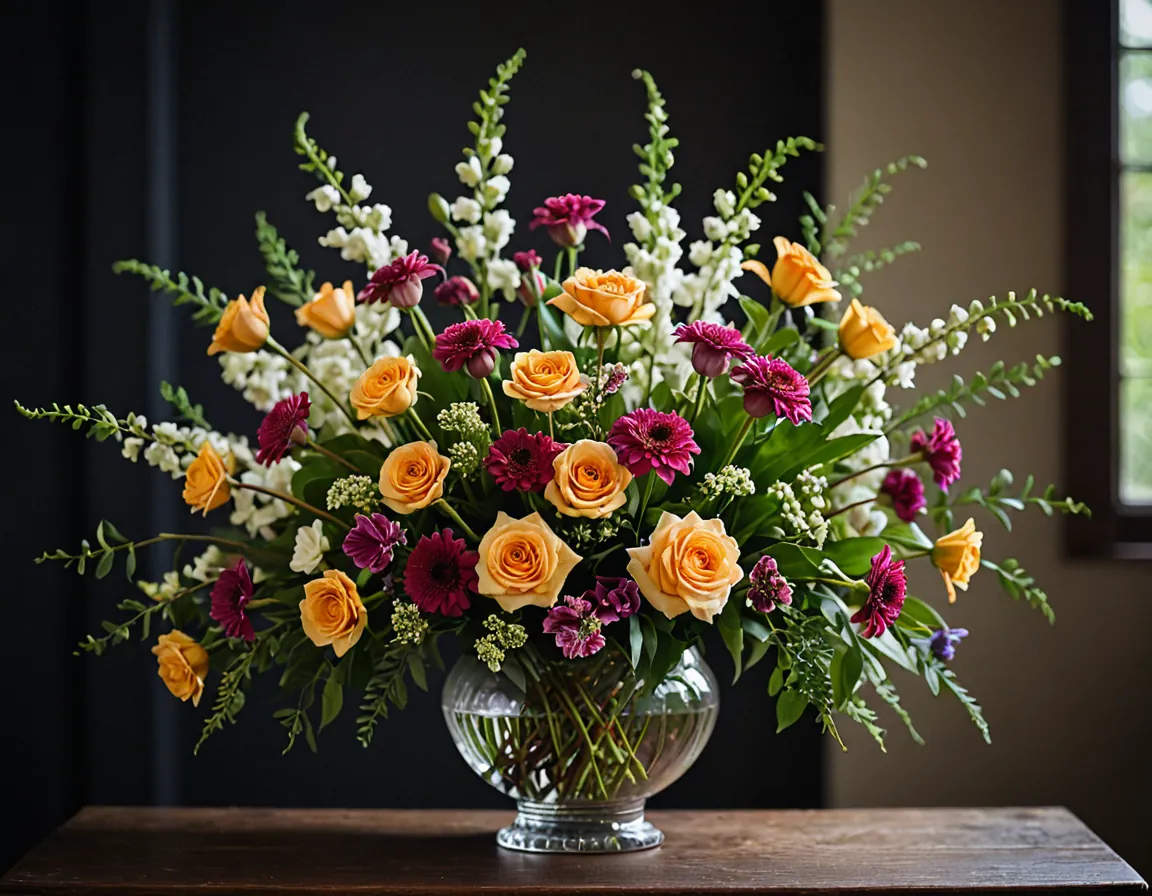Arranging flowers professionally can transform any space into a delightful visual experience. Here, we will explore various techniques to help you master the art of floral arrangement.
1. Choosing the Right Flowers
Choosing the right flowers is crucial for creating stunning arrangements. Consider factors like color, size, and shape.
Factors to Consider:
| Factor | Description | Example |
|---|---|---|
| Color | Choose colors that complement each other or create a striking contrast. | Red roses with white lilies. |
| Size | Mix different sizes for a balanced look. | Large sunflowers with small daisies. |
| Shape | Combine different shapes to add interest and texture. | Round peonies with spiky delphiniums. |
Popular Flower Choices:
| Flower | Season | Characteristics |
|---|---|---|
| Roses | Year-round | Classic, romantic, various colors |
| Tulips | Spring | Elegant, simple, vibrant colors |
| Lilies | Summer | Fragrant, large blooms, dramatic presence |
| Sunflowers | Summer | Cheerful, large, bright yellow petals |
| Chrysanthemums | Fall | Diverse shapes and sizes, autumnal colors |
2. Preparing the Flowers
Proper preparation ensures your flowers stay fresh longer.
Steps for Preparation:
- Cut Stems at an Angle: Use sharp scissors or a knife to cut the stems at a 45-degree angle. This increases the surface area for water absorption.
- Remove Leaves Below Water Line: Leaves submerged in water can rot and create bacteria, which shortens the flowers’ lifespan.
- Hydrate: Place the cut flowers in water immediately after trimming.
Tools You Need:
| Tool | Purpose |
|---|---|
| Sharp scissors/knife | Cutting stems cleanly |
| Vase | Holding and displaying flowers |
| Floral tape | Securing arrangements in place |
| Flower food | Extending the life of your arrangement |
3. Creating a Balanced Arrangement
Balance is key to an attractive flower arrangement.
Tips for Balance:
- Height Variation: Arrange flowers at varying heights to create depth and dimension.
- Focal Point: Choose a central flower to act as the focal point and build around it.
- Symmetry vs. Asymmetry: Decide whether you want a symmetrical or asymmetrical look.
Step-by-Step Guide:
- Choose a Vase: Select a vase that suits the size and style of your arrangement.
- Start with Foliage: Begin by adding greenery to create a base.
- Add Focal Flowers: Place your focal flowers in the center or slightly off-center.
- Fill with Secondary Flowers: Add smaller, secondary flowers around the focal points.
- Finish with Fillers: Use filler flowers like baby’s breath to fill in any gaps.
4. Color Theory in Floral Arrangements
Understanding color theory can enhance your floral designs.
Color Schemes:
| Scheme | Description | Example |
|---|---|---|
| Monochromatic | Different shades of a single color | Various shades of pink roses |
| Analogous | Colors next to each other on the color wheel | Yellow, orange, and red tulips |
| Complementary | Colors opposite each other on the color wheel | Blue delphiniums with orange lilies |
| Triadic | Three evenly spaced colors on the color wheel | Red roses, yellow sunflowers, and blue irises |
Using Color Schemes:
- Monochromatic: Create a sophisticated, cohesive look.
- Analogous: Achieve a harmonious and pleasing arrangement.
- Complementary: Make a bold, vibrant statement.
- Triadic: Introduce variety while maintaining balance.
5. Special Techniques for Professional Arrangements
Using Floral Foam:
Floral foam helps secure flowers in place and provides them with water.
How to Use:
- Soak the Foam: Submerge the foam in water until fully saturated.
- Cut to Fit: Trim the foam to fit the shape of your container.
- Insert Stems: Push the flower stems into the foam to secure them.
Wiring and Taping:
Wiring and taping can provide extra support for delicate flowers.
Steps:
- Cut a Piece of Floral Wire: About 6 inches long.
- Pierce the Stem: Insert the wire through the base of the flower head.
- Wrap with Floral Tape: Cover the wire and stem with floral tape for a natural look.
Layering Techniques:
Layering adds depth and texture to your arrangements.
Methods:
- Horizontal Layering: Place flowers in horizontal layers, starting with the largest flowers at the bottom.
- Vertical Layering: Arrange flowers in vertical layers, with the tallest flowers in the center.
6. Seasonal Arrangements
Different seasons offer unique flowers and styles.
Seasonal Themes:
| Season | Characteristics | Flower Examples |
|---|---|---|
| Spring | Fresh, vibrant, pastel colors | Daffodils, tulips, hyacinths |
| Summer | Bright, bold, large blooms | Sunflowers, peonies, dahlias |
| Fall | Warm, earthy tones, textured foliage | Chrysanthemums, marigolds, asters |
| Winter | Cool tones, festive elements | Poinsettias, holly, amaryllis |
Tips for Each Season:
- Spring: Use light, airy designs with soft colors.
- Summer: Incorporate bold, vibrant flowers in large arrangements.
- Fall: Add texture with leaves and branches in warm tones.
- Winter: Combine cool tones with festive elements like berries and pinecones.
Conclusion
Mastering the art of flower arrangement involves understanding flower types, preparation, balance, color theory, special techniques, and seasonal variations. With these detailed techniques, you can create stunning, professional floral arrangements that captivate and delight.
Feel free to adjust the content as needed and add images to illustrate each step and technique for better engagement and understanding.
